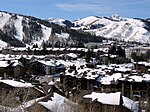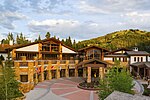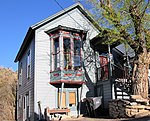Deer Valley Music Festival
Classical music festivals in the United StatesMusic festivals in UtahTourist attractions in Wasatch County, Utah
The Deer Valley Music Festival is the summer home of the Utah Symphony and Utah Opera. It occurs each summer in July and August in Park City, Utah at the Deer Valley Resort, St. Mary's Church, Temple Har Shalom, and salon performances in local homes. The festival features the Utah Symphony and its guests performing chamber music, symphonic music, opera, and popular music. The festival is known for collaborations between popular artists and the Utah Symphony including Elvis Costello, LeAnn Rimes, Gladys Knight, Frederica von Stade, Jewel, Tony Bennett, Ben Folds, the Mormon Tabernacle Choir, Pink Martini, Randy Travis, Idina Menzel, Kansas, and Earth, Wind & Fire.
Excerpt from the Wikipedia article Deer Valley Music Festival (License: CC BY-SA 3.0, Authors).Deer Valley Music Festival
Royal Street,
Geographical coordinates (GPS) Address Nearby Places Show on map
Geographical coordinates (GPS)
| Latitude | Longitude |
|---|---|
| N 40.622777777778 ° | E -111.48944444444 ° |
Address
Goldener Hirsch Inn
Royal Street 7570
84060
Utah, United States
Open on Google Maps








